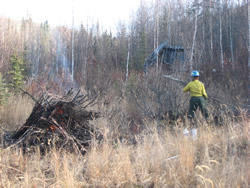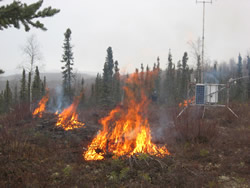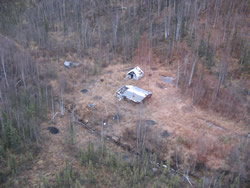
National Fire Plan Success Story
Wildland Fire Happens, Fire Managers Prepare
Yukon-Charley Rivers National Preserve, Alaska
National Fire Plan - Fuels Reduction
2008

Fire staff builds hazard fuel piles at the Ben Creek Mine.

Fire staff monitors burning piles near Ben Creek remote automated weather station.

Can you find the pile remains? A new look for the Ben Creek Mine after the project ends.
For three days in late September, National Park Service (NPS) fire personnel traveled to 8 remote areas of Yukon-Charley Rivers National Preserve to burn 5 acres of hazard fuel piles near backcountry structures. Favorable early winter weather conditions allowed staff to burn the piles. Three years prior, fire staff thinned the vegetation adjacent to the structures and piled the biomass. Pile burning, the final step in the fuels reduction project, is an integral part of maintaining defensible space and reducing the wildland fire risk at remote structures.
NPS Eastern Area Fire Management, the program responsible for fire management in Yukon-Charley Rivers National Preserve, coordinated a safe and successful project by collaborating with NPS and Bureau of Land Management (BLM) employees. All involved provided qualified personnel, necessary aviation assets and an aptitude for teamwork. NPS Western Area Fire Management staff, based in Denali National Park and Preserve, participated in the ignition and burn monitoring. Maintenance and law enforcement employees at the preserve provided key logistical support by boating equipment to the Coal Creek airstrip staging area. All of the structures were accessed by helicopter with NPS and BLM dispatchers provided flight following. Dispatchers also communicated fire weather intelligence to the burn crew. In addition, the preserve subsistence coordinator advised fire staff about suitable burning dates due to helicopter and smoke impact concerns during the subsistence-hunting season.
The protection of remote structures during a wildland fire is a primary fire management objective in the preserve, which averages about 16,000 wildland fire acres per year. The 2008 pile burning not only exemplifies teamwork but also is a beneficial step towards reducing the wildland fire risk to remote structures and ensuring that future fires can be managed successfully.
Contact: James Savage, Assistant Fire Management Officer or Andrew Ruth, Supervisory Forestry Technician, (907) 455-0651 or (907) 455-0654.